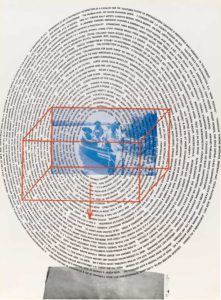Ownership History
San Francisco Museum of Modern Art, gift of Marion B. Javits, Robert Rauschenberg, and Milton Glaser, 1992
Exhibition History
Exhibition history not provided for multiples.
Publication History
Hilton Kramer, “Art: Over 53 Feet of Wall Decoration,” New York Times, January 23, 1968, ill.
Andrew Forge, Rauschenberg (New York: Harry N. Abrams, 1969), 135 (ill.).
Richard Kostelanetz, Master Minds: Portraits of Contemporary American Artists and Intellectuals (New York: Macmillan, 1969), 255.
Douglas M. Davis, “Rauschenberg’s Recent Graphics,” Art in America 57, no. 4 (July–August 1969): 95.
Lawrence Alloway, “The Graphic Art of Robert Rauschenberg,” in Rauschenberg: Graphic Art (Philadelphia: Institute of Contemporary Art, University of Pennsylvania, 1970), 5.
Edward A. Foster, Robert Rauschenberg: Prints 1948/1970 (Minneapolis: Minneapolis Institute of Arts, 1970), n.p. (ill.).
Mike Steele, “Rauschenberg—The Artist Is Daring,” Minneapolis Tribune, August 30, 1970.
Lawrence Alloway, “Rauschenberg’s Graphics,” Art and Artists 5, no. 6 (September 1970): 18, 19 (listed as Visual Autobiography).
Donald H. Karshan, “Graphics ’70: Robert Rauschenberg,” Art in America 58, no. 6 (November–December 1970): 48.
Walter Hopps, ed., Robert Rauschenberg (Washington, D.C.: National Collection of Fine Arts, Smithsonian Institution, 1976), 3, 46.
Paul Richard, “‘Goofy, Grand’ Rauschenberg,” Washington Post, October 30, 1976, ill.
John Gruen, “Robert Rauschenberg: An Audience of One,” ARTnews 76, no. 2 (February 1977): 45.
Charles F. Stuckey, “Reading Rauschenberg,” Art in America 65, no. 2 (March–April 1977), 74 (ill.), 76.
Cathy Curtis, “Turning Urban Soil,” Daily Californian, June 24, 1977, (ill.).
Robert Rauschenberg: Retrospective, directed by Michael Blackwood (New York: Michael Blackwood Productions, 1979), VHS, 45 min.
Dieter Ruckhaberle, ed., Rauschenberg: Werke 1950–1980, trans. Janni Müller-Hauck and Vincent Thomas (Berlin: Staatliche Kunsthalle Berlin, 1980), 40, 46, 47, 48, 52, 53.
Carter Ratcliff, “Mostly Monochrome,” Art in America 69, no. 4 (April 1981): 116.
Roger Cranshaw and Adrian Lewis, “Re-Reading Rauschenberg,” Artscribe 29 (June 1981): 47, 48 (ill.), 49.
Rauschenberg (Madrid: Fundación Juan March, 1985), n.p.
Roni Feinstein, “The Early Work of Robert Rauschenberg: The White Paintings, the Black Paintings, and the Elemental Sculptures,” Arts Magazine 61 (September 1986): 37n14.
John Cage, Michel Nuridsany, Nina Sundell, et al., Robert Rauschenberg (Paris: Galerie Fabien Boulakia, 1990), 15, 18, 67 (ill.).
Roni Feinstein, “Random Order: The First Fifteen Years of Robert Rauschenberg’s Art, 1949–1964” (PhD diss., New York University, 1990), 131n16, 384, 387–88, 470.
———, ed., Robert Rauschenberg: The Silkscreen Paintings, 1962–1964 (New York: Whitney Museum of American Art, 1990), 21.
Mary Lynn Kotz, Rauschenberg, Art and Life (New York: Harry N. Abrams, 1990), 113, 155, 156 (ill.).
Ruth E. Fine and Mary Lee Corlett, Graphicstudio: Contemporary Art from the Collaborative Workshop at the University of South Florida (Washington, D.C.: National Gallery of Art, 1991), 255n11.
Kathleen Slavin, Robert Rauschenberg: A Print Survey in Themes, 1952–1992 (New York: Castelli Gallery, 1992).
Seiji Oshima, Marjorie Welish, Takeshi Yoshizumi, et al., The Second Hiroshima Art Prize: Robert Rauschenberg (Hiroshima: Hiroshima City Museum of Contemporary Art, 1993), 27 (ill.), 32.
Mark Lesly Smith, “Suspended Shadows: The Miniature Blueprints of Rauschenberg & Weil,” Print Collector’s Newsletter 24, no. 4 (September–October 1993): 126.
Robert Saltonstall Mattison, Masterworks in the Robert and Jane Meyerhoff Collection: Jasper Johns, Robert Rauschenberg, Roy Lichtenstein, Ellsworth Kelly, Frank Stella (New York: Hudson Hills Press, 1995), 114.
Bernice Rose, Robert Rauschenberg: Anagrams (New York: PaceWildenstein, 1996), 10.
Cornelia Faist, Catherine Craft, Billy Klüver, et al., Robert Rauschenberg: Haywire: Major Technological Works of the 1960s (Ostfildern-Ruit: Verlag Gerd Hatje, 1997), 28.
Walter Hopps and Susan Davidson, eds., Robert Rauschenberg: A Retrospective (New York: Solomon R. Guggenheim Museum, 1997), 201 (ill.), 229, 230, 242n18, 386–87.
Branden W. Joseph, Random Order: Robert Rauschenberg and the Neo-Avant-Garde (Cambridge, MA: MIT Press, 2003), 216.
Robert Saltonstall Mattison, Robert Rauschenberg: Breaking Boundaries (New Haven, CT: Yale University Press, 2003), 23, 24, 187.
Susan Davidson and David White, eds., Rauschenberg (Ferrara, Italy: Ferrara Arte, 2004), 50 (ill.), 51–52, 70, 71n4.
Manuel Mortari, “Nel territorio tra arte e realtà,” Art e Dossier no. 198 (March 2004): 11.
Dorothy Kosinski, Dialogues: Duchamp, Cornell, Johns, Rauschenberg (New Haven, CT: Yale University Press, 2005), 62, 64–65 (ill.), 66, 71–72, 73 (ill.), 89.
Mirta D’Argenzio, ed., Robert Rauschenberg: Travelling ’70|’76 (Milan: Electa, 2008), 31, 49, 52n10, 176, 216 (ill.), 217 (ill.), 245.
Bruno Marchand, ed., Robert Rauschenberg: Crítica e obra de 1949 a 1974 (Porto, Portugal: Fundação de Serralves, 2008), 23, 27, 29, 142 (ill.).
Susan Davidson, “Robert Rauschenberg,” Guggenheim Museum Bilbao Collection (Bilbao: Guggenheim Bilbao, 2009), 97n42.
Lewis Kachur, Past Pop: Robert Rauschenberg and James Rosenquist Graphics (Union, NJ: Kean University, 2009), 6 (ill.), 7–8, 33 (ill.).
Branden W. Joseph, Random Order: Robert Rauschenberg et la néo-avant-garde, trans. Anaël Lejeune, Olivier Mignon, and Raphaël Pirenne (Brussels: Continental Rift, 2012), 256.
Catherine Craft, Robert Rauschenberg (London: Phaidon, 2013), 92 (ill.), 93, 97 (ill.).
Lauren Acampora, “Conner’s Films and Rauschenberg’s Filmic Time,” in Rauschenberg: Collecting & Connecting, ed. Kristine Stiles (Durham, NC: Nasher Museum of Art, 2014), 52–53 (ill.); online edition. Accessed February 9, 2015. https://shuffle.rauschenbergfoundation.org/exhibitions/nasher/essays/Acampora_films/.
Kristine Stiles, “Rauschenberg, Looking Long and Thinking Hard,” in Rauschenberg: Collecting & Connecting, ed. Stiles (Durham, NC: Nasher Museum of Art, 2014), 11; online edition. Accessed February 9, 2015. https://shuffle.rauschenbergfoundation.org/exhibitions/nasher/essays/Stiles_introduction.
Kristine Stiles, Concerning Consequences: Studies in Art, Destruction, and Trauma (Chicago: University of Chicago Press, 2016), 289.
This listing documents select references that provide general information about the print. It has been updated since the launch of the Rauschenberg Research Project and is complete as of August 31, 2016.





